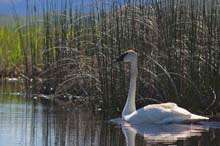No products in the cart.
Beloved Trumpeter

The Swans’ Resurgence Sparks Research
Story and Photos by Paige Miller
On a late May morning in the heart of Bear Lake Valley, I sat in the passenger seat of a pickup truck while a U.S. Fish and Wildlife Service biologist slowly drove around looping dirt roads between open marshes. He stopped periodically to orient me on our current location, while I scribbled in a tiny notebook in my lap. A breeze that carried the smell of soil and greenery flowed over our faces as we peered through the truck’s open windows. Binoculars in hand, we glanced over miles of tall vegetation and open waters as we searched for our needle in a haystack.
“I see a white bird!” someone in the truck exclaimed.
We all lurched forward in our seats as the driver hit the brakes. It wasn’t long before I saw her as well, sticking out of the bulrushes like a sore thumb. She sat in the center of a carefully-constructed nest. An impressively large bird: plump body, toothpick neck, feathers white as snow. A trumpeter swan.
“That’s Rainbow,” the biologists said as I watched her through my binoculars.
Like many Idaho birds, trumpeter swans often return to their preferred nesting spots year after year. Rainbow was given her nickname because she nests every summer in the Rainbow Unit of the Bear Lake National Wildlife Refuge. Apparently, Rainbow is also Idaho’s greatest hide-and-go-seek player, because for years she has evaded biologists’ efforts to capture her and put an identification collar on her. Fortunately, we can still learn a lot about trumpeters without having to catch them.
This content is available for purchase. Please select from available options.
Purchase Only
Purchase Only

